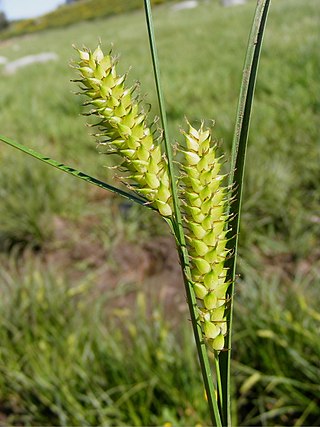
Carex vesicaria is an essentially Holarctic species of sedge known as bladder sedge, inflated sedge, and blister sedge. It has been used to insulate footwear in Norway and among the Sami people, and for basketry in North America.

Carex pilulifera, the pill sedge, is a European species of sedge found in acid heaths, woods and grassland from Macaronesia to Scandinavia. It grows up to 30 cm (12 in) tall, with 2–4 female spikes and 1 male spike in an inflorescence. These stalks bend as the seeds ripen, and the seeds are collected and dispersed by ants of the species Myrmica ruginodis.
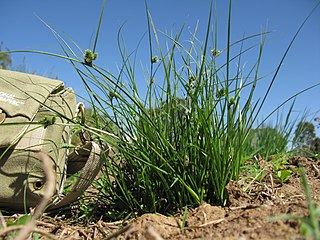
Carex inversa, commonly known as knob sedge, is a species of sedge of the family Cyperaceae that is native to parts of Australia and New Zealand and has also been introduced into Great Britain.

Carex brevior, known as shortbeak sedge and plains oval sedge, is a species of sedge native to North America. The specific epithet brevior means "shorter" in Latin.
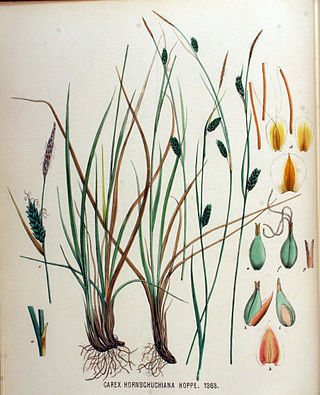
Carex hostiana, the tawny sedge, is a species of flowering plant in the genus Carex, native to Europe and northeast Canada, and extinct in Massachusetts. It is a member of the Carex flava species complex.

Carex breviscapa is a tussock-forming perennial in the family Cyperaceae. It is native to eastern parts of the south east Asia and north eastern Australia

Carex scaposa, also known as hua ting tai cao in Chinese, is a tussock-forming species of perennial sedge in the family Cyperaceae. It is native to eastern parts of Asia.

Carex cruenta is a tussock-forming species of perennial sedge in the family Cyperaceae. It is native to parts of Asia, from Pakistan in the west to south central parts of China in the east.

Carex gaudichaudiana, also known as fen sedge, is a tussock-forming species of perennial sedge in the family Cyperaceae. It is native to parts of Australia and New Zealand.

Carex donnell-smithii is a tussock-forming species of perennial sedge in the family Cyperaceae. It is native to parts of Mexico and Central America.
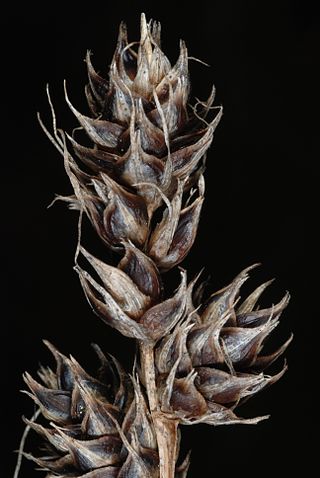
Carex gravida, also known as heavy-fruited sedge, heavy sedge or long-awned bracted sedge, is a tussock-forming species of perennial sedge in the family Cyperaceae. It is native to southern parts of Canada and parts of the United States.
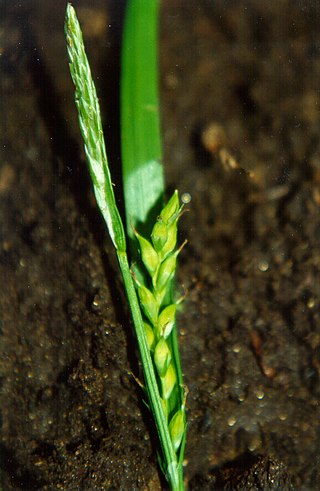
Carex hendersonii, also known as Henderson's sedge or carex de Henderson, is a tussock-forming species of perennial sedge in the family Cyperaceae. It is native to western parts of North America.
Carex graeffeana is a tussock-forming species of perennial sedge in the family Cyperaceae. It is native to parts of Malesia and islands of the south western Pacific Ocean.
Carex interrupta is a tussock-forming species of perennial sedge in the family Cyperaceae. It is native to south eastern parts of Canada and north eastern parts of the United States.
Carex krausei, commonly known as Krause's sedge or carex de Krause in Canada, is a tussock-forming species of perennial sedge in the family Cyperaceae. It is native to subarctic areas of Greenland, Alaska, northern Canada and Russia.

Carex michauxiana, also known as Michaux's sedge, carex de Michaux or yellowish sedge in Canada, is a tussock-forming species of perennial sedge in the family Cyperaceae. It is native to eastern parts of North America and parts of Asia.

Carex uruguensis is a tussock-forming species of perennial sedge in the family Cyperaceae. It is native to parts of South America.
Carex cephalotes, also known as wire-head sedge, is a tussock-forming species of perennial sedge in the family Cyperaceae. It is native to south eastern Australia and New Zealand.

Carex digitalis is a tussock-forming species of perennial sedge in the family Cyperaceae. It is native to south eastern parts of Canada as well as central and eastern parts of the United States.

Carex vestita, also commonly known as velvet sedge, is a tussock-forming species of perennial sedge in the family Cyperaceae. It is native to eastern parts of the United States.















